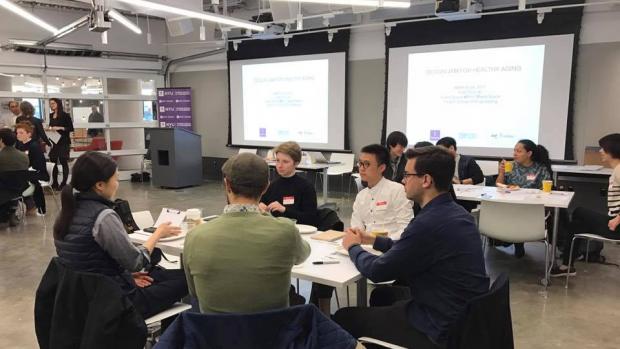Designing with Empathy
Multidisciplinary Design Jam brings together innovative thinkers across NYU

On March 24, participants from seven NYU schools, including the Tandon School of Engineering, the Meyers College of Nursing, the College of Global Public Health, and the Tisch School of Arts, gathered in the MakerSpace for the Design Jam for Healthy Aging to collaboratively answer and design solutions to the question, “How might we enable older adults to live their best possible life by preventing falls?”
Professor Anne-Laure Fayard of Technology, Management and Innovation conceived the Design Jam as a “cross-disciplinary collaboration between NYU programs for innovation and social impact.” Through the support of a VentureWell grant and a partnership with OpenIDEO, the open social innovation platform spearheaded by the global design and consulting firm IDEO, Fayard’s idea evolved into a day-long workshop undertaking the Fall Prevention Challenge through a human-centered design approach. Sponsored by AARP Services Inc. and UnitedHealthcare, the OpenIDEO challenge aims to address the highly prevalent problem of falls in older individuals and determine products, services, and ideas to ensure safe and healthy aging.
Joanna Spoth of OpenIDEO kicked off the day’s activities, listing the opportunity areas within the challenge, such as softening the stigma of aging as “not a decline, but a possibility,” incorporating daily exercise to prevent falls, and reimagining devices, like the walker or other assistive products and technologies.
Divided into six teams, the 32 participants brought their varied expertise and academic training to the table. “In designing a product, you have to have different backgrounds, experience, and knowledge to work together to form a universal, adaptive design,” participant Runyu “Louie” Yan, a graduate student in psychology currently taking Fayard’s Design Thinking course, said. Other participants joined the Design Jam to strengthen their design thinking skills and to hone their own products and ideas. Rodney Lobo, a graduate student in Technology, Management and Innovation at Tandon, is currently working on the Design for America (DFA) NYU project, the Mobility Device for the Elderly, and hoped to gain more insight and ideas from his team members towards building better assistive devices.

Throughout the brainstorming session and ideation process, advisors from AARP and OpenIDEO stopped by each group’s design spaces, offering insight and suggestions. In her role as a facilitator at the Design Jam, Bettina Fliegel, MD — a pediatrician, DFA NYU mentor, and active OpenIDEO member — was excited to see how the teams developed ideas that were “human-centered, creative and different.” Adhish Patel, a graduate student in Tandon’s Management of Technology program, and Shradda Bhatia, an alumna of NYU Steinhardt and a clinical doctorate of physical therapy, shared their expertise to steer the teams towards practical and accessible solutions.
As the end of the day neared, the energy spiked in the room as groups added finishing touches to their designs before presenting to the judges. One team fashioned a “Caregiving in Action” training program for older couples and programs to help strengthen their relationship in this new life stage. Another idea is an interactive phone application that generates an avatar of the user and shares data with their doctor, who can check their daily physical activity and discern actions that could lead to falls.
After the judges deliberated, Fayard announced that the six teams’ ideas were both promising and human-centered (two criteria used to evaluate the ideas) and all six teams were eligible to receive up to $250 in funding to continue with prototyping and participate in the OpenIDEO ideation phase in the coming month. Many of the teams have posted their ideas on the OpenIDEO fall prevention challenge’s page, with some students adding their personal designs as well. Tuba Naziruddin, a graduate student in Technology, Management and Innovation at Tandon, was inspired by how her team easily coalesced. “We’d never met each other before, but we were so focused and in sync with coming up with an idea to the challenge,” Naziruddin said, adding that she and her teammates are excited to move forward with their design.
“The Design Jam was a great success in terms of participation, collaboration, energy and ideas generated. It’s really exciting to see so many teams ready to continue refining their idea and prototype,” Fayard said. “This is usually the hardest part after an event like this: to keep the momentum and the collaborations going. I'm really looking forward to seeing some of the ideas evolve.”
Camila Ryder
Graduate School of Arts and Science
Master of Arts in English Literature, Class of 2018




